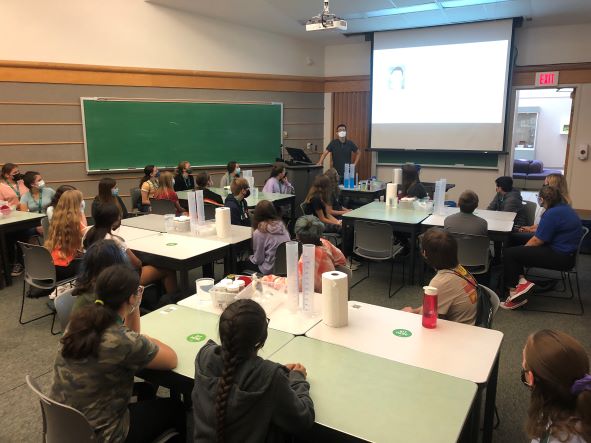A grant from the Association of Environmental Engineering and Science Professors (AEESP) Foundation for pilot education modules has enabled Clarkson University’s Beacon Institute for Rivers & Estuaries to provide new enrichment opportunities for K-12 students.

Through the experience of piloting several education modules in 2021, Beacon will provide new in-class, field trip, and summer programs to students in New York’s Greater Hudson Valley, including Beacon City School District and eight other districts.
The goal of the project was to develop modules providing K-12 students with the basic principles and engineering concepts behind conventional and new water and wastewater treatment processes.
The modules were designed by co-principal investigators Assistant Professor of Chemical and Biomolecular Engineering Taeyoung Kim and Assistant Professor of Civil and Environmental Engineering Yang Yang.
“I was inspired by my four-year-old daughter having fun with water experiments that she can explore using easily accessible items at home during the pandemic,” says Kim. “Prof. Yang is a perfect collaborator who has so many things in common with me, such as research area, expertise in electrochemistry, and, especially, raising a child of the same age.”
The two professors developed hands-on experiments for three grade levels – K-5, middle school and high school – to pose two science questions related to their research expertise.
The modules designed by Kim answered the question “Why can’t we use seawater in our daily life?” and Yang’s modules answered “How can we remove dirt from water?”
The learning objectives were for the students to understand how impaired water sources affect daily water uses, apply engineering solutions to remove undesired compounds, and analyze the working principles using water chemistry fundamentals.
The educational staff at Beacon delivered one of the pilot modules to 100 sixth-grade students from South Middle School in Newburgh during a field trip to Beacon’s Water Ecology Center. The demonstration illustrated the low availability of freshwater resources versus saltwater on earth. Students created water filters and established an action plan for conserving water in their daily lives.
Kim delivered several modules to middle school students during Clarkson’s Horizons Program. The students performed water distribution and soap bubble experiments, made a simple water filtration system using coffee filters and granular activated carbon, and removed water hardness by pouring hard water into a coffee filter filled with ion-exchange resin beads.
“These activities were designed to introduce several water quality standards – like salinity, hardness, and pH – and water treatment processes – like filtration, adsorption, and ion exchange,” says Kim. “The most common misconception we identified was about the freshwater distribution. The learning activity not only helped us to address this, but it also raised the children’s awareness of the globe’s limited freshwater resources.”
Yang’s module includes hands-on laboratory experience and lecture materials to demonstrate the principles of electron flow, redox chemistry, and electrocatalysis. “The science kits we designed visualized the jargon in the textbook,” says Yang. “Beyond the lab content, we introduced the recent advances in energy storage and electrochemical water treatment.”
Assisted by graduate students, Yang’s module was showcased at a North Country Children’s Museum summer camp, where K-5 students used the science kit to build fruit batteries, corrosion cells, and water-splitting devices.
A pilot module was also delivered to K-5 students by Potsdam’s North Country Children’s Museum science staff and a Clarkson undergraduate student. During the program, titled “The Wonders of Water,” students used a sieve to separate sand from steel balls, representing membrane-based processes like reverse osmosis. A second activity used a magnet to remove the steel balls from sand, which represents an electro-driven process using ion-exchange membranes.
“The project demonstrates the power of collaboration between Clarkson faculty and our STEM Ed outreach staff,” said Clarkson Beacon Institute for Rivers & Estuaries Director of Environmental Programs Asher Pacht. “Together, we can impact students of all ages with programs to make complex science both understandable and inspiring.”
Pilot project collaborators included Pacht and Clarkson Beacon Institute for Rivers & Estuaries Assistant Director of Environmental Programming Brigette Walsh; Clarkson’s Horizons Program Director and Assistant Professor of the Institute for STEM Education Melissa Richards; and North Country Children’s Museum staff member Dan Bellinger ’16, assisted by Clarkson chemical engineering major Carolyne Shultes ’23.
